Overview
Have you ever felt overwhelmed by the business-to-business (B2B) buying process? You're not alone! This article breaks down ten essential steps to help you master it. It all starts with recognizing and defining your problems—after all, how can you find a solution if you don’t know what the issue is? Then, it’s all about researching the right solutions and building strong relationships with suppliers.
As you dive into each step, you'll see how evaluating vendors and leveraging technology can boost your efficiency and effectiveness in procurement. Imagine making better decisions that lead to operational success! By following these steps, you’ll not only streamline your process but also enhance your overall business strategy.
So, are you ready to take your B2B buying process to the next level? Let’s get started on this journey together!
Introduction
Navigating the intricacies of the business-to-business (B2B) buying process can often feel like traversing a labyrinth, right? With technology evolving at lightning speed and market demands shifting, organizations face a pressing challenge: how do they optimize their purchasing strategies to stay competitive?
In this article, we’ll explore ten essential steps that not only streamline the B2B buying experience but also show how companies can leverage innovative solutions like Equip360 to enhance efficiency and build strong supplier relationships.
But amidst this pursuit of improvement, how can businesses ensure they are effectively addressing their unique challenges? Let’s dive in!
GenAlpha Technologies: Streamlining the B2B Buying Process with Equip360
Have you ever felt overwhelmed by managing inventory and online sales? Well, GenAlpha Technologies has got your back with Equip360, a B2B eCommerce platform focused on simplifying the business-to-business buying process to make your life easier. This platform is designed to optimize inventory management and boost digital sales performance, all while integrating seamlessly with your existing ERP systems.
Imagine simplifying the business-to-business buying process for manufacturers and distributors. Equip360 does just that! It helps you manage your online sales more effectively, streamlining transactions and enhancing customer engagement. It’s truly an essential tool for any organization looking to thrive in today’s digital landscape.
So, why not take your sales to the next level? Equip360 is here to help you navigate the complexities of eCommerce with ease!
Recognize the Problem or Need
Have you ever noticed a problem or need within your organization? Maybe it’s those pesky operational inefficiencies, outdated technology, or perhaps a gap in your product offerings. By clearly identifying these issues, you can kickstart a targeted search for solutions that directly address your unique challenges. This way, you ensure that your resources are allocated efficiently and strategically. So, what’s the first step you’ll take to tackle these challenges?
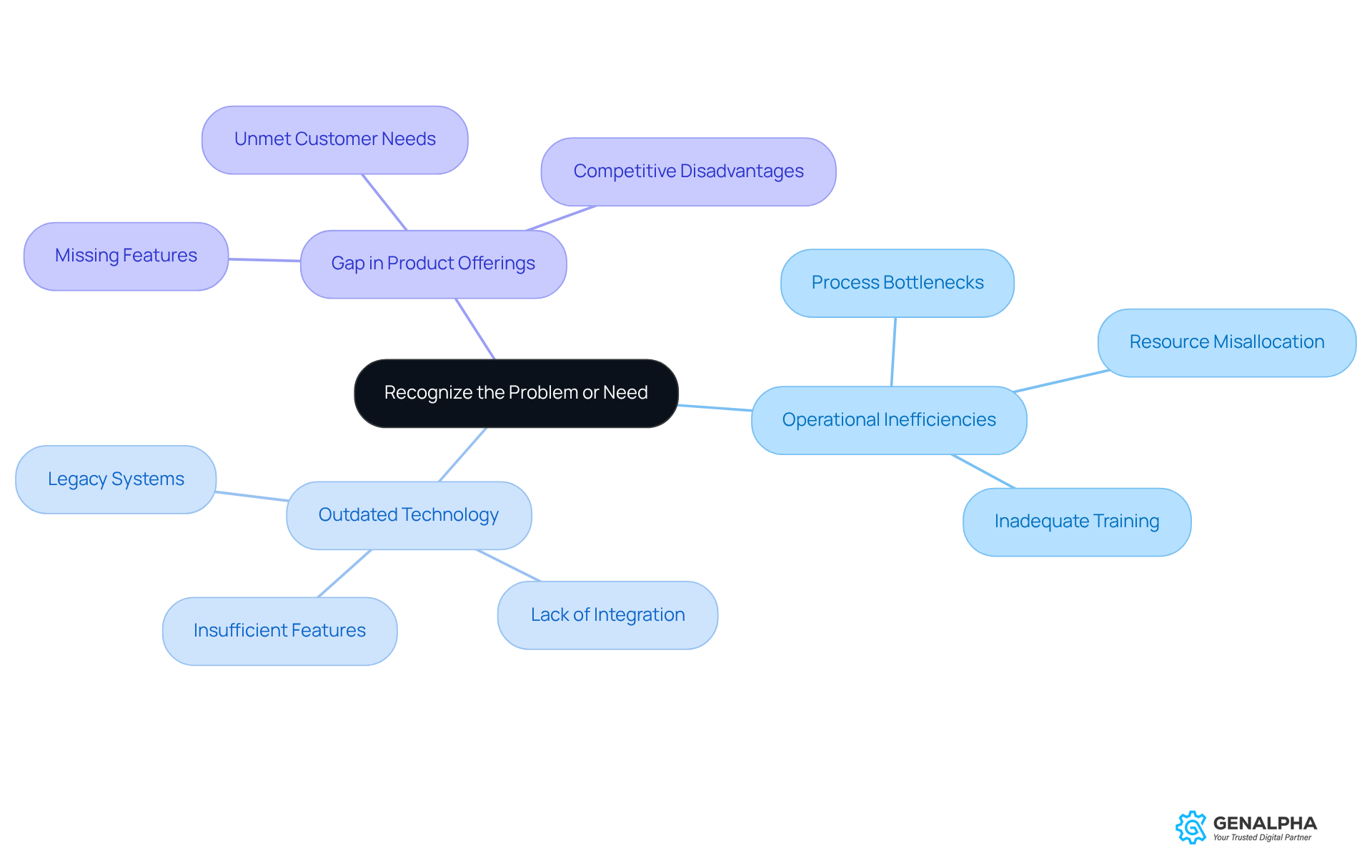
Define the Problem
Defining the problem in detail is a crucial step in the B2B purchasing journey. It’s not just about recognizing the issue; it’s about gathering comprehensive data to analyze its impact and understand the desired outcomes. When we articulate the problem well, it helps align everyone involved, ensuring that all stakeholders are on the same page regarding objectives. For instance, when stakeholders clearly outline their challenges, they can explore options that directly address these concerns, leading to a smoother purchasing experience.
Case studies really highlight the importance of this approach in manufacturing. Take, for example, a manufacturing firm that struggled with operational inefficiencies because decision-makers weren’t aligned on the core problems. By implementing regular check-ins and collaborative discussions, they refined their problem definition process, which led to a remarkable 38% increase in win rates when stakeholders agreed on the problem statement, as noted by Emblaze.
Additionally, data shows that a staggering 54.5% of misalignment exists between how sellers and buyers perceive the core problems that need solving. This statistic emphasizes the need for clear communication, as it can lead to ineffective outcomes and wasted resources. So, investing time in thorough data analysis not only clarifies the issues at hand but also enhances the overall business-to-business buying process. As a result, organizations can make informed decisions that drive efficiency and effectiveness in their operations.
How can we ensure that we’re all on the same page moving forward?
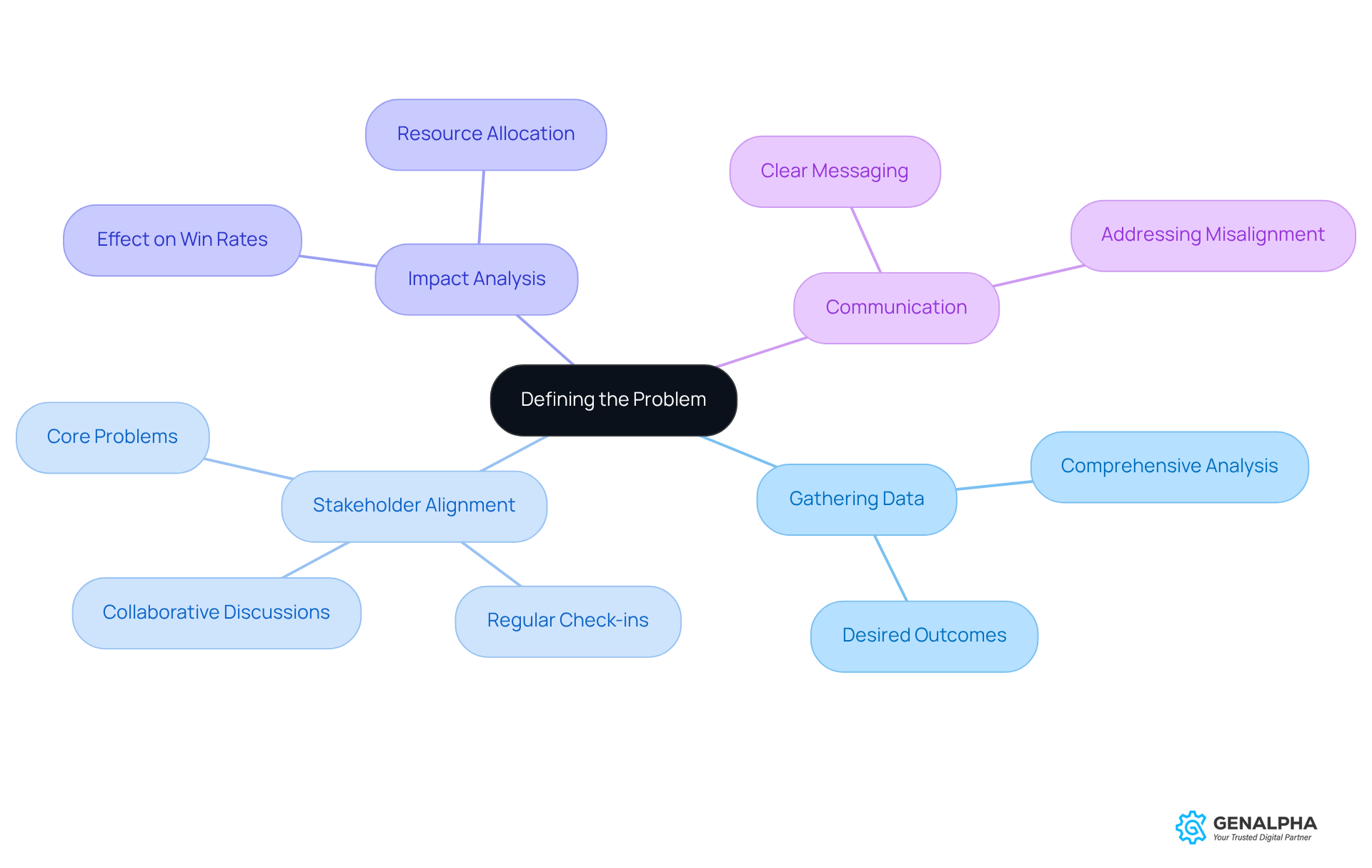
Research Solutions
Once we’ve outlined the issue, it’s time for companies to dive into some thorough research to uncover potential solutions. This means checking out various vendors, technologies, and products that could meet the needs we've identified in the business-to-business buying process. By tapping into resources like industry reports, customer feedback, and case studies, we can gain valuable insights into how effective different approaches can be. For instance, did you know that over 65% of organizations using ERP software have turned to cloud-based options? This really highlights their crucial role in boosting operational efficiency.
Now, let’s consider a real-world example: FloMAX’s switch to GOb2b. This move has not only streamlined their eCommerce operations but also ramped up customer satisfaction. In fact, this transition led to a whopping 35% reduction in B2B sales and marketing costs for The North Face! It’s a clear illustration of the tangible benefits that come from making smart vendor choices in the business-to-business buying process.
By leveraging these insights and examples, we can ensure our decisions align perfectly with our strategic goals and operational needs. So, what steps will you take to explore these options further?
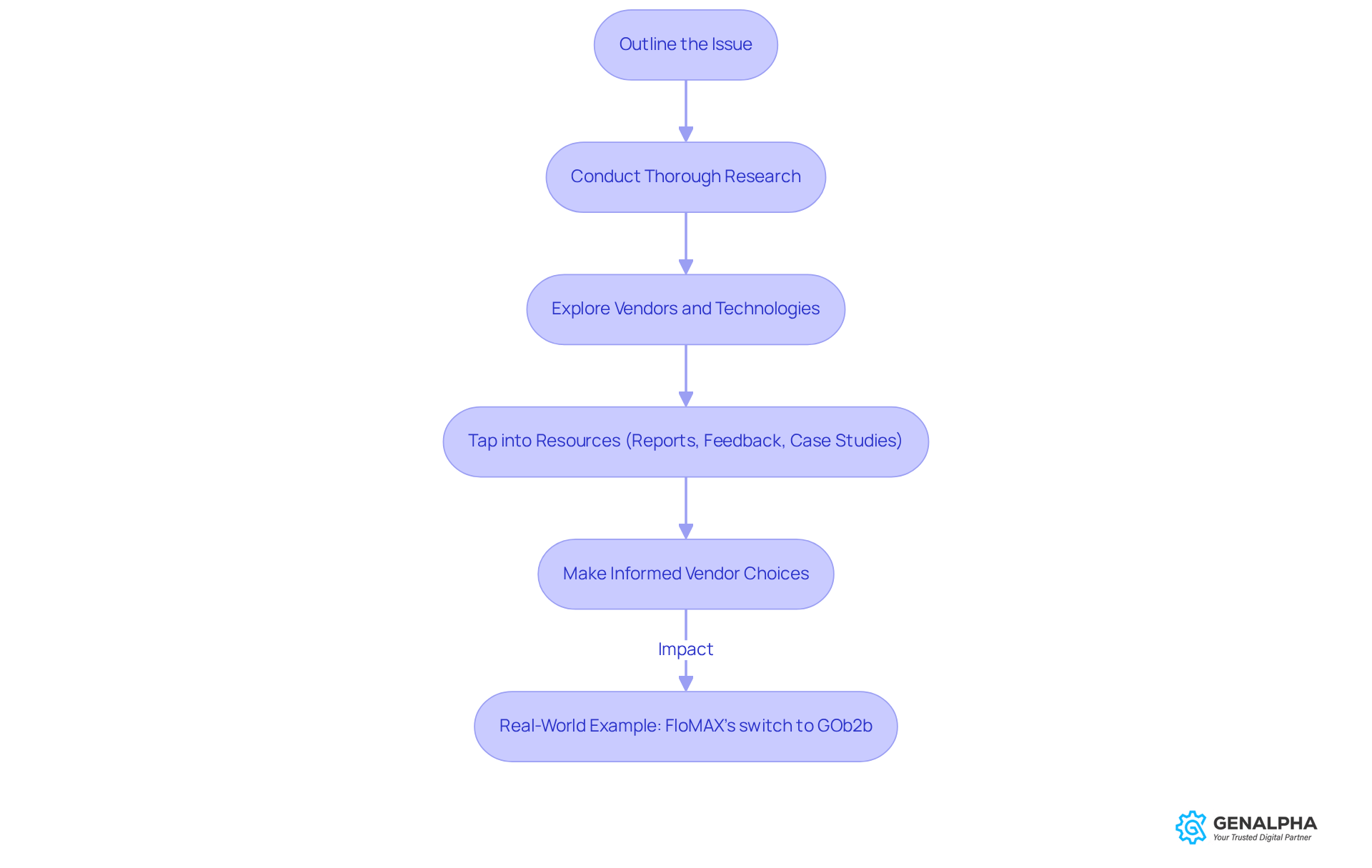
Request Quotes from Suppliers
Once we've identified some possible solutions, the next step in the business-to-business buying process is to reach out to vendors for quotes. This means contacting those selected vendors during the business-to-business buying process and sharing the detailed specifications of the products or services we need. By gathering multiple quotes in the business-to-business buying process, we can easily compare pricing, terms, and conditions. This way, we can choose the most cost-effective and suitable option that meets our needs during the business-to-business buying process.
Have you ever found a better deal just by asking around? It's amazing what you can discover!
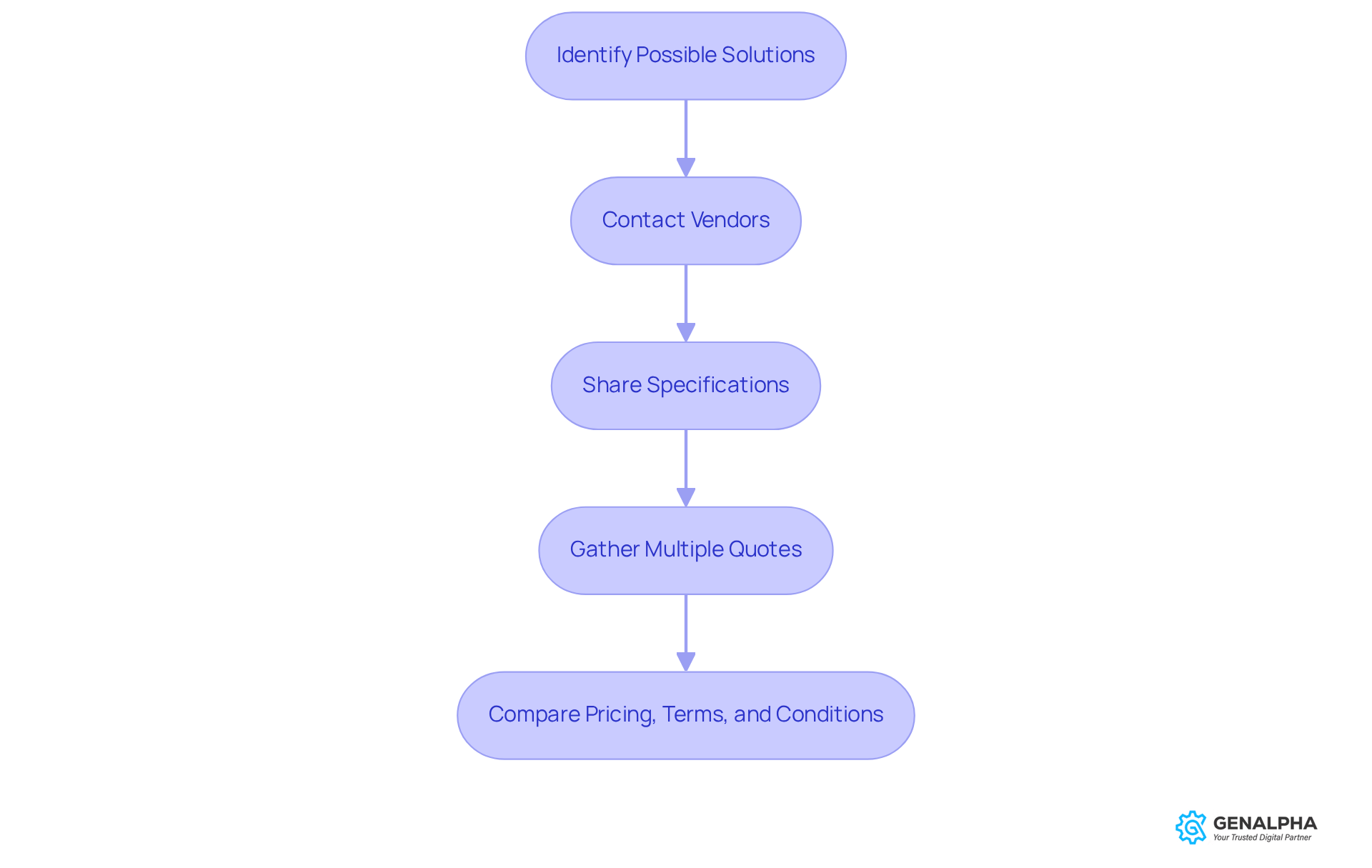
Compare Providers
When it comes to the business-to-business buying process, it’s essential for businesses to closely examine various potential vendors. Think about it: you wouldn’t want to make a decision based solely on one factor, right? Instead, you should compare them based on several key criteria, like price, quality, delivery times, and customer service. A comparison matrix can be a game-changer here, helping to clearly illustrate these differences and making your decision-making process a lot smoother. This structured approach not only ensures that you stick to your budget but also that the vendor meets your quality standards and service expectations.
So, what should you be looking for when evaluating suppliers in the equipment industry? Here are some important criteria to consider:
- Quality Assurance: How does the supplier ensure their products meet quality standards? Look into their inspection methods and any certifications they hold.
- Cost Competitiveness: Are their pricing frameworks reasonable? Can they maintain those prices over time?
- Delivery Performance: Check their history for on-time deliveries, especially if they operate in areas that might face disruptions.
- Customer Service: How responsive is their customer service team? Are they there to support you when you need them?
- Financial Stability: You want to ensure the provider is financially sound enough to keep up with your ongoing business needs.
- Continuous Improvement: Does the vendor have a culture of continuous improvement? Those who prioritize this often perform better in the long run.
- Risk Management: What strategies do they have in place for managing risks? This includes their disaster recovery plans and how they comply with regulations.
By incorporating these criteria into your comparison matrix, you can make informed decisions in the business-to-business buying process that effectively balance cost and quality. For example, if you find a vendor with a solid quality management system, it might be worth paying a bit more for them because of the reduced risk of defects and the costs that come with them. Ultimately, taking the time for a thorough assessment can lead to stronger supplier relationships and boost your overall operational efficiency. So, what’s your next step in vendor evaluation?
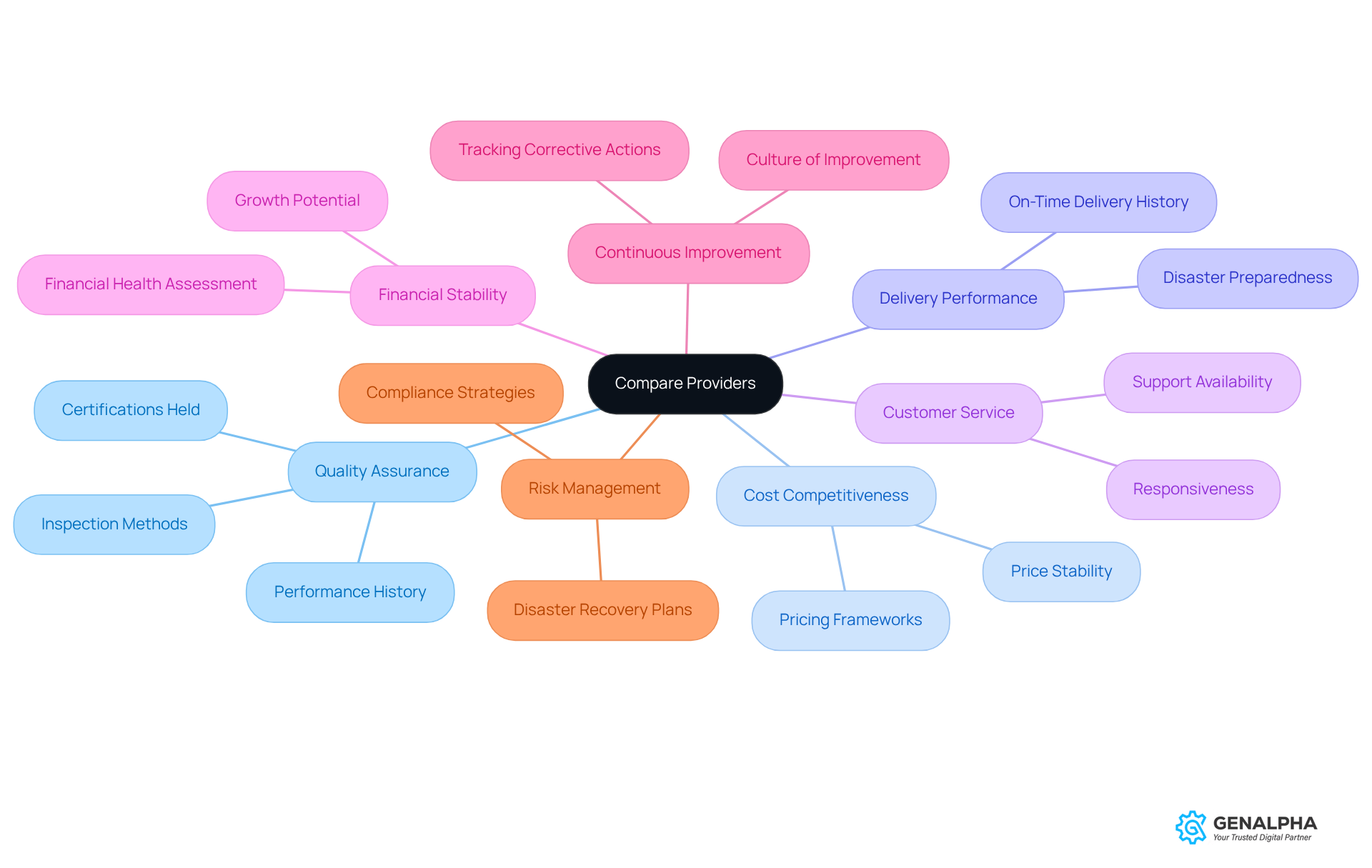
Complete the Purchase
Once you've chosen a provider, the next big step is to wrap up the purchase. This means finalizing the contract, checking payment terms, and placing the order. It's super important to document everything accurately and communicate clearly to avoid any mix-ups and ensure a smooth transaction. For example, when companies procure equipment, they often negotiate specific terms that detail delivery schedules, warranty conditions, and payment milestones. These factors can really impact cash flow and operational efficiency.
Platforms like Equip360 are game changers in streamlining these processes. By automating order management and offering real-time tracking of deliveries, Equip360 helps reduce errors and boosts visibility throughout the procurement cycle. Plus, the choice of payment conditions—whether it's upfront, net 30, or installment payments—can significantly affect a company's financial health. Flexible payment options not only enhance cash flow but also strengthen relationships between buyers and suppliers, showing a commitment to meeting everyone's needs. Interestingly, transitioning to digital merchandising can cut the combined sales, marketing, and customer service budgets of manufacturers by an average of 10.3%.
Experts agree that having a solid contract and clear payment terms is key to the successful business-to-business buying process. They recommend having thorough discussions during the negotiation phase of the business-to-business buying process to ensure all parties are on the same page, which can lead to better outcomes and lasting partnerships. As noted in the LinkedIn State of Sales Report 2024, 54% of sales leaders believe that aligning sales and marketing directly contributes to revenue growth. By utilizing tools like Equip360, businesses can refine their procurement strategies within the business-to-business buying process, ultimately driving efficiency and growth in a competitive market.
Moreover, adopting digital solutions like Equip360 supports sustainability by reducing the need for printed materials, which aligns with today’s environmental values. To make these strategies work for you, think about negotiating payment terms that offer flexibility while ensuring clarity and alignment with your partners. What are your thoughts on implementing these ideas in your own procurement process?
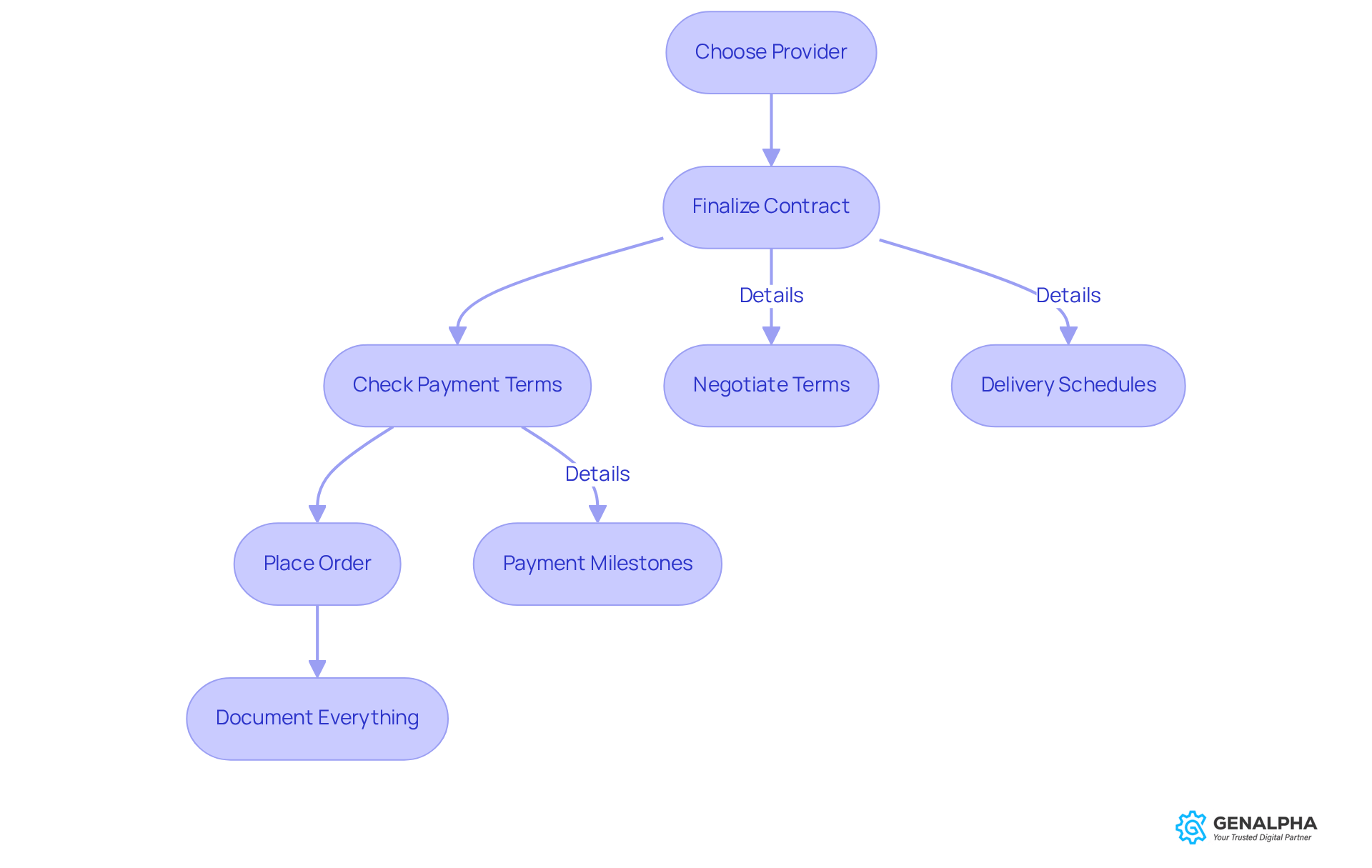
Evaluate the Buying Process
Once you've wrapped up your purchase, it’s a great idea to take a moment and reflect on the whole buying experience. Reflect on:
- How smoothly everything went at each stage of the business-to-business buying process.
- How effectively you communicated with your suppliers.
- Whether you are satisfied with your purchases.
Have you ever thought about how collecting feedback from everyone involved can really shine a light on what worked and what didn’t? This feedback can be a goldmine for shaping your future procurement strategies and enhancing the business-to-business buying process. So, why not take that step? It could lead to some fantastic improvements down the line!
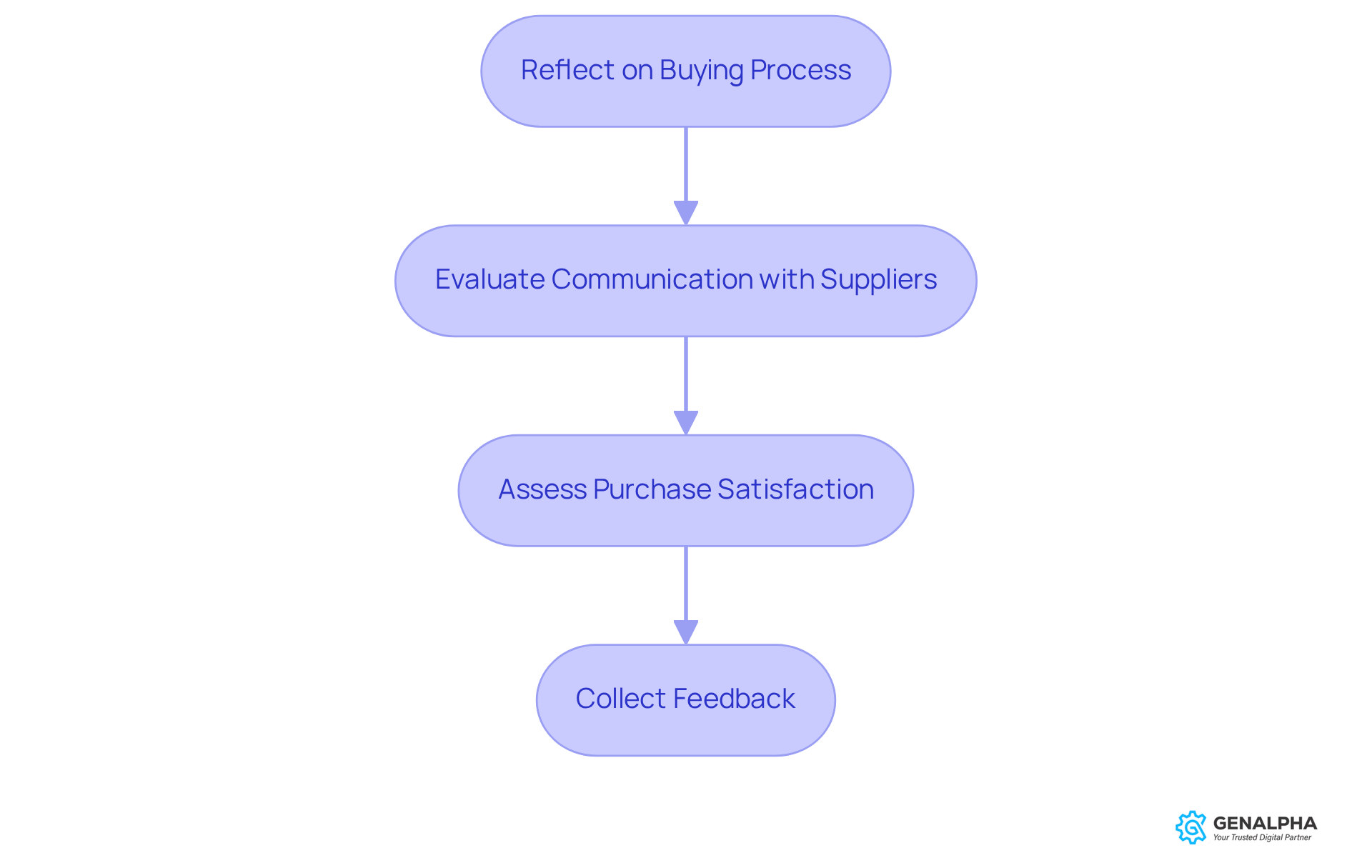
Leverage Technology for Enhanced Buying
In today's digital world, leveraging technology is essential for streamlining the business-to-business buying process. Take Equip360, for example—it offers automated order processing, real-time inventory tracking, and advanced data analytics, all of which can really boost procurement efficiency. Remember, "the potential vendor must assure the buyer they are getting the best solution for their needs." This really underscores how important automated systems are in meeting buyer expectations.
By using these digital tools, companies can cut down on manual errors, improve communication with providers, and create a more efficient purchasing experience. For instance, businesses that have embraced automated order processing have seen a 25% jump in online revenue. In fact, TruPar recorded a 25% increase in online revenue after they implemented OroCommerce. These examples highlight the real benefits of these innovations.
Moreover, automated systems speed up decision-making by giving instant access to crucial data, enabling organizations to respond quickly to market demands. As the B2B landscape continues to evolve, adopting such technologies is essential for staying competitive in the business-to-business buying process. So, why not explore how these tools can work for you?
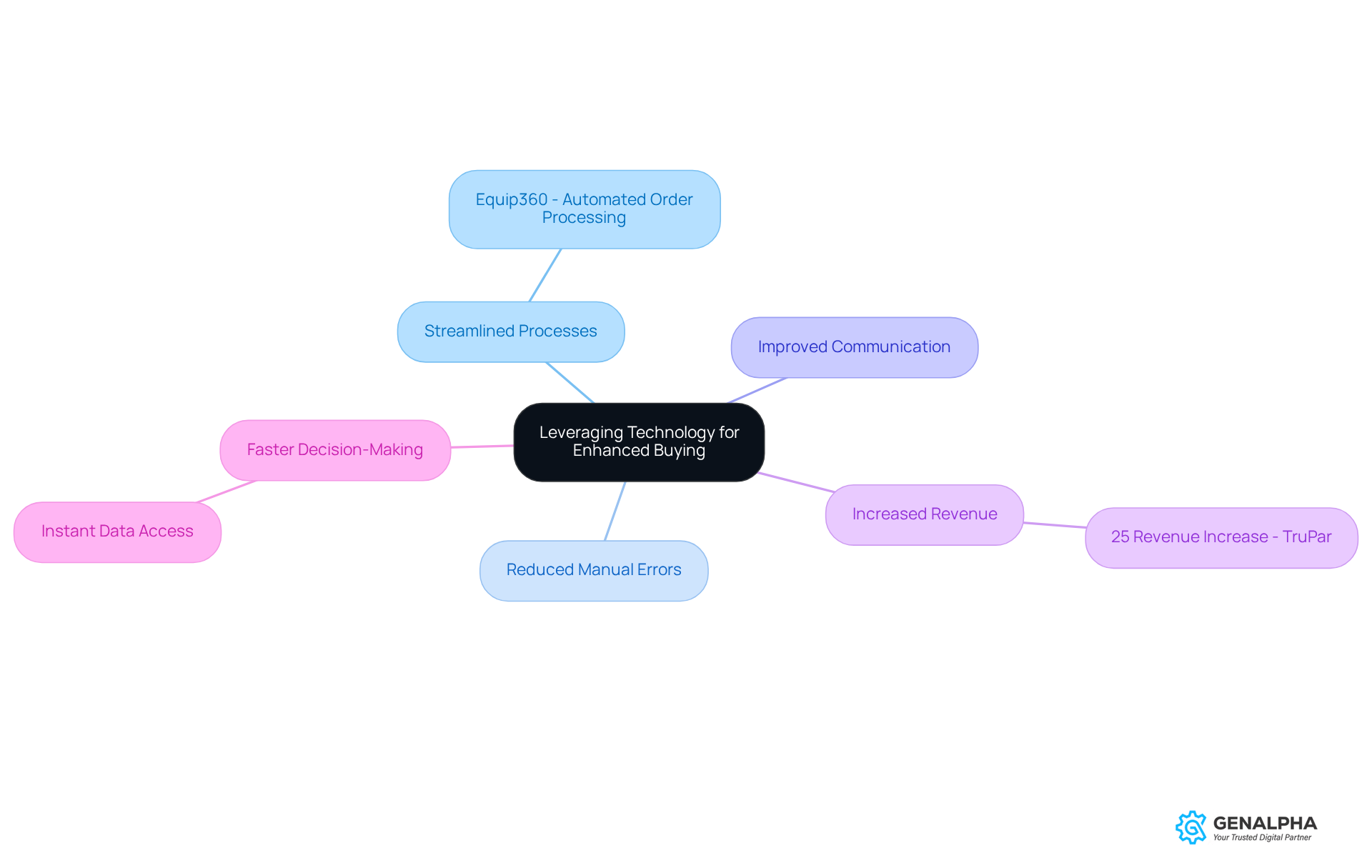
Build Relationships with Suppliers
Building relationships with suppliers is key to long-term success in the business-to-business buying process. Think about it: regular communication, transparency, and collaboration can really boost service levels, lead to better pricing, and enhance product offerings. By investing in these relationships, we can create a network of reliable partners that not only support our operational goals but also contribute to overall business growth. So, how can you start nurturing these connections today?
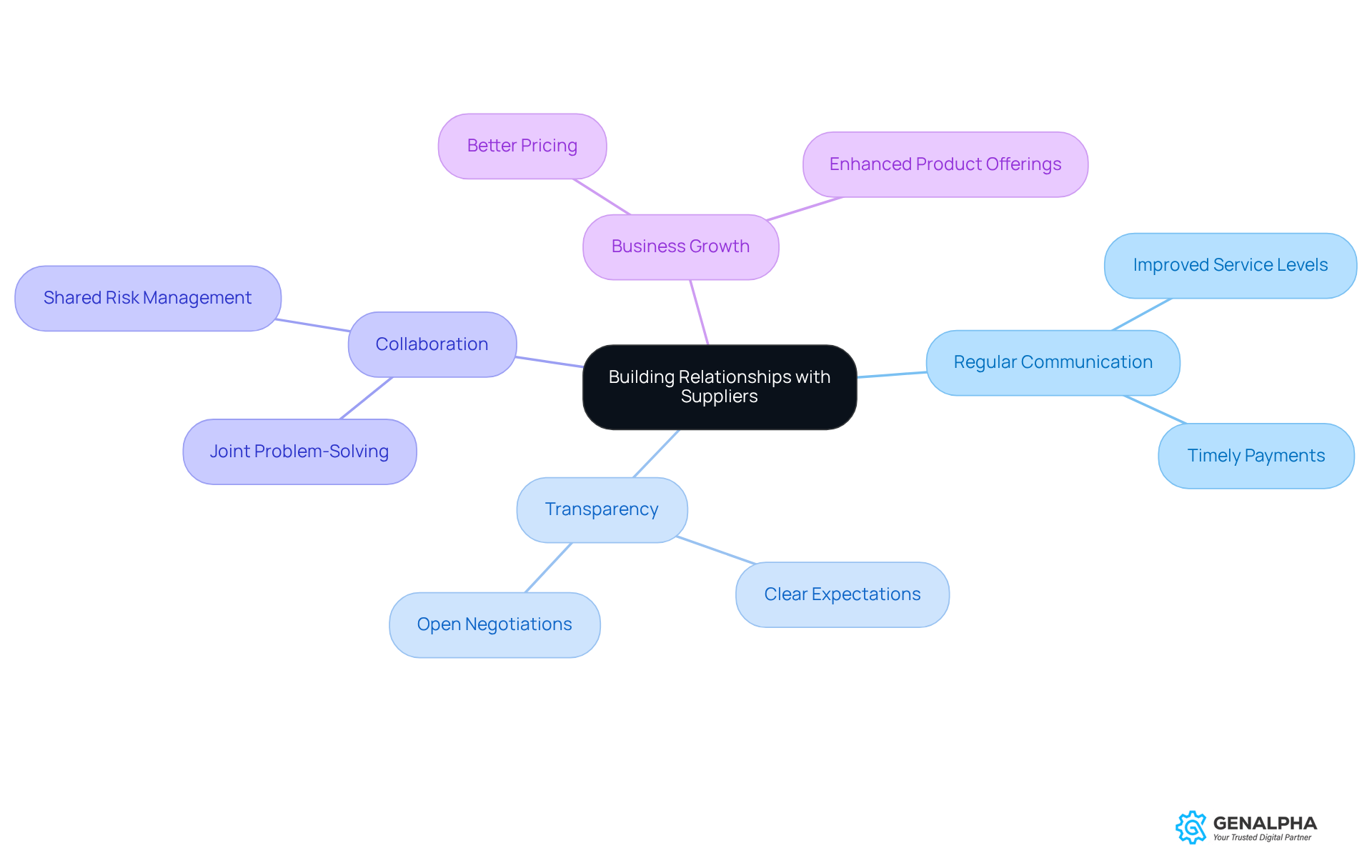
Conclusion
Streamlining the business-to-business buying process is crucial for companies wanting to boost their operational efficiency and customer satisfaction. Have you ever felt overwhelmed by the complexities of procurement? By taking a structured approach, organizations can navigate these challenges—from identifying and defining problems to utilizing technology and fostering strong supplier relationships. This comprehensive framework not only leads to better decision-making but also helps businesses thrive in a competitive landscape.
Let’s break down some key steps:
- Recognizing your needs is essential.
- Conducting thorough research and requesting quotes from suppliers can provide valuable insights.
- Evaluating the overall purchasing experience is critical.
Each of these stages plays a vital role in ensuring that organizations make informed choices that align with their strategic objectives. Plus, integrating technology like Equip360 shows just how important modern solutions are for simplifying processes and enhancing communication.
Ultimately, embracing these best practices and leveraging innovative tools can significantly improve the B2B buying process. So, why not take a moment to reflect on your current procurement strategies? Consider how you can implement these insights to build stronger relationships with suppliers and drive sustainable growth. Adopting a proactive approach not only empowers your organization to meet its operational goals but also positions you for long-term success in an ever-evolving market. Ready to take the next step?
Frequently Asked Questions
What is Equip360 and how does it help businesses?
Equip360 is a B2B eCommerce platform developed by GenAlpha Technologies that simplifies the business-to-business buying process. It optimizes inventory management and boosts digital sales performance while integrating seamlessly with existing ERP systems.
What are the main benefits of using Equip360?
The main benefits of Equip360 include more effective management of online sales, streamlined transactions, enhanced customer engagement, and the ability to navigate the complexities of eCommerce more easily.
What initial steps should organizations take to address operational challenges?
Organizations should first recognize any problems or needs within their operations, such as inefficiencies, outdated technology, or gaps in product offerings. Identifying these issues allows for a targeted search for solutions that directly address unique challenges.
Why is defining the problem important in the B2B purchasing journey?
Defining the problem in detail is crucial because it involves gathering comprehensive data to analyze its impact and understand desired outcomes. A clear articulation of the problem helps align all stakeholders, leading to a smoother purchasing experience.
Can you provide an example of the importance of problem definition in manufacturing?
Yes, a manufacturing firm that struggled with operational inefficiencies improved its win rates by 38% after decision-makers aligned on core problems through regular check-ins and collaborative discussions. This highlights the significance of clear communication in addressing challenges.
What is the statistic regarding misalignment between sellers and buyers?
Data indicates that there is a 54.5% misalignment between how sellers and buyers perceive the core problems that need solving. This emphasizes the need for clear communication to avoid ineffective outcomes and wasted resources.
How does thorough data analysis benefit the B2B buying process?
Investing time in thorough data analysis clarifies the issues at hand and enhances the overall B2B buying process, allowing organizations to make informed decisions that drive efficiency and effectiveness in their operations.




